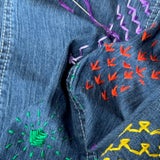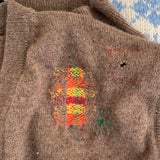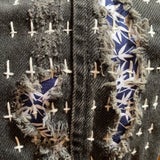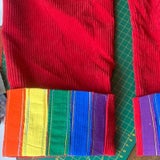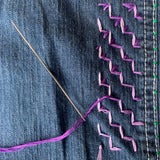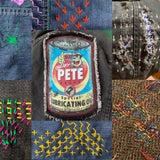- Pete Cant
- >
- ONLINE Visible Mending: An Introduction - Thurs 26th January 2023 at 10am
ONLINE Visible Mending: An Introduction - Thurs 26th January 2023 at 10am
SKU:
PC2601aa12
£38.00
£38.00
Unavailable
per item
If you wish to take part but are unable to attend the workshop demo live, please select the recording only option below.
All students will be given access to watch our video playback service of this workshop for 60 days.
Sold out
Tutor: Pete Cant
Thurs 26th January 10am - 12pm
(UK timings)
This LivePlus™ online workshop is ideal for everyone who has an interest in reusing, repurposing and revamping their clothes. We will focus on the idea of mending but these techniques can also be used to up-cycle and customise any piece of clothing.
Workshop details
In this exciting and useful workshop you will learn a number of techniques that will enable you to give a new lease of life to old, damaged or unloved clothes. Techniques will include appliqué, making and using patches, traditional darning and the Japanese art Sashiko.
In the modern world, the garment industry has become one of the biggest polluters of fresh water on the planet. With 300,000 tons of textiles finding their way into landfill sites every year in the UK alone, it is our collective responsibility to take a little more care of our clothes and make them last a little longer. In this easy and fun workshop, Pete will teach you how to simply and effectively mend small, damaged areas of loved clothing in a visible way - a wonderful way to not only stop the damage progressing further, but to give a new focus point to the garment and let the outside world know “I’m ethical!”
We will be learning about appliqué; the process of covering a hole/damaged area with another fabric cut into a design to complement the existing garment. We will also cover how to use this same technique to create patches that can be used to cover damage or given as gifts.
We will also look at darning; the process of using wool or thread to weave a new section that is integrated into the existing garment fabric, usually used on knitted garments but can be used on any fabric. And Japanese Sashiko, which is the process of using contrasting and decorative stitching to secure a new layer of fabric to close a hole or simply to add a feature to a garment.
You won't need to sew or darn along during the live demonstration – it is a time to watch, ask and learn - but you may want to have to hand an item or two that you are looking to mend or customise. Pete will be setting aside time during the class to help students with inspiration for their own cherished items of clothing.
Specific skills you will learn at the workshop
Equipment & materials list
Materials are not included in the course fee. All the materials and equipment you will need are listed below.
This list is for guidance only - you can improvise and source your own materials, either in advance or once you have seen the LivePlus™ workshop, giving you maximum flexibility to choose how you would like to approach this craft.
Links to suppliers
All items can be purchased at most haberdasheries and fabric shops, or at an endless number of places online. For a one-stop shop, in person or online, Pete would recommend HobbyCraft
Additional Information
All Ardington ONLINE classes and talks are accompanied by their own online blackboard. Helpful and easy to use, they enable students and tutors to share resources, ideas and photos with each other – just as you would in a classroom environment.
Pete will offer personalised critique / feedback via the blackboard for any projects uploaded by students within thirty days of the class ending. You will be sent the link to access your blackboard in the week before your class begins and will have access for at least sixty days after the class ends.
After the live session has finished on Zoom, we will share the link to view the recording on the blackboard. You can watch the recording as many times as you like for sixty days.
Thurs 26th January 10am - 12pm
(UK timings)
This LivePlus™ online workshop is ideal for everyone who has an interest in reusing, repurposing and revamping their clothes. We will focus on the idea of mending but these techniques can also be used to up-cycle and customise any piece of clothing.
Workshop details
In this exciting and useful workshop you will learn a number of techniques that will enable you to give a new lease of life to old, damaged or unloved clothes. Techniques will include appliqué, making and using patches, traditional darning and the Japanese art Sashiko.
In the modern world, the garment industry has become one of the biggest polluters of fresh water on the planet. With 300,000 tons of textiles finding their way into landfill sites every year in the UK alone, it is our collective responsibility to take a little more care of our clothes and make them last a little longer. In this easy and fun workshop, Pete will teach you how to simply and effectively mend small, damaged areas of loved clothing in a visible way - a wonderful way to not only stop the damage progressing further, but to give a new focus point to the garment and let the outside world know “I’m ethical!”
We will be learning about appliqué; the process of covering a hole/damaged area with another fabric cut into a design to complement the existing garment. We will also cover how to use this same technique to create patches that can be used to cover damage or given as gifts.
We will also look at darning; the process of using wool or thread to weave a new section that is integrated into the existing garment fabric, usually used on knitted garments but can be used on any fabric. And Japanese Sashiko, which is the process of using contrasting and decorative stitching to secure a new layer of fabric to close a hole or simply to add a feature to a garment.
You won't need to sew or darn along during the live demonstration – it is a time to watch, ask and learn - but you may want to have to hand an item or two that you are looking to mend or customise. Pete will be setting aside time during the class to help students with inspiration for their own cherished items of clothing.
Specific skills you will learn at the workshop
- Darning
- Appliqué
- Patch making
- Hand stitching
- Sashiko mending/stitching
Equipment & materials list
Materials are not included in the course fee. All the materials and equipment you will need are listed below.
- Hand sewing needles. Pete recommends darning needles as they are longer than regular needles and make stitching a straight line easier. They also have a larger eye so you can use thicker thread, such as like embroidery thread
- Tapestry needle (optional but will be easier to thread if using wool for darning a woollen garment)
- Darning mushroom OR an embroidery hoop
- A selection of threads - these can be normal sewing cotton, wool, embroidery thread or top stitching thread depending on the technique you wish to use
- Sewing machine - not at all essential but will make certain aspects of appliqué and patch making faster and easier
- Fabric for appliqué, patches and Sashiko - this can be scrap fabric, a different garment that you are willing to cut up. Pete recommends sturdy cottons like quilting cotton or poplin or something with a similar weight. Avoid anything too fine/floaty or anything stretchy as these will be difficult to work with and will not give a long-lasting finish.
- A small amount of felt or denim to help stabilise patches if making them
- Posca paint pens if designing or colouring your own patches
This list is for guidance only - you can improvise and source your own materials, either in advance or once you have seen the LivePlus™ workshop, giving you maximum flexibility to choose how you would like to approach this craft.
Links to suppliers
All items can be purchased at most haberdasheries and fabric shops, or at an endless number of places online. For a one-stop shop, in person or online, Pete would recommend HobbyCraft
Additional Information
All Ardington ONLINE classes and talks are accompanied by their own online blackboard. Helpful and easy to use, they enable students and tutors to share resources, ideas and photos with each other – just as you would in a classroom environment.
Pete will offer personalised critique / feedback via the blackboard for any projects uploaded by students within thirty days of the class ending. You will be sent the link to access your blackboard in the week before your class begins and will have access for at least sixty days after the class ends.
After the live session has finished on Zoom, we will share the link to view the recording on the blackboard. You can watch the recording as many times as you like for sixty days.

